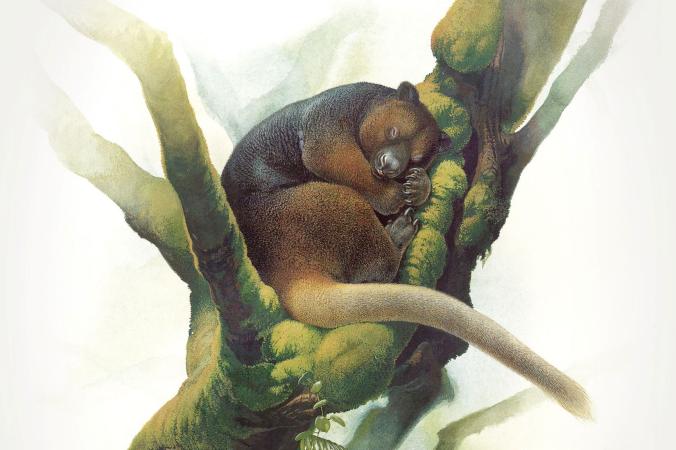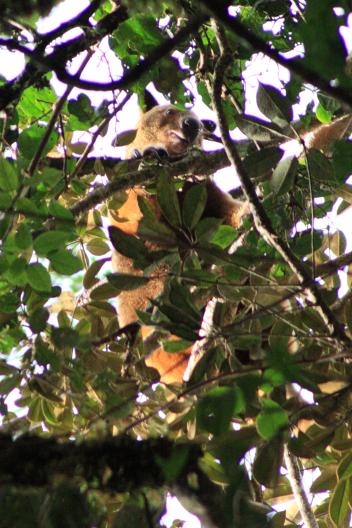Rare Tree Kangaroo Reappears After Vanishing for 90 Years
Once thought to be extinct, the Wondiwoi tree kangaroo has just been photographed in a remote New Guinea mountain range.

The ultra-rare Wondiwoi tree kangaroo was last recorded by scientists in 1928, and researchers only had drawings like this one to go on. It has now been photographed in a remote New Guinea mountain range. (illustration: Peter Schouten).
The unusual monkey-like kangaroo clambers through the trees of the montane forests of New Guinea. It had been seen there only once before by Western scientists, in 1928.
The Wondiwoi tree kangaroo had not been collected, seen, or reported since that first sighting. “It is one of the most poorly known mammals in the world,” says Mark Eldridge, a marsupial biologist at the Australian Museum in Sydney.
Now an amateur botanist from the U.K. has led an expedition into near-impenetrable bamboo forests 5,000 feet high in the remote Wondiwoi Mountains of West Papua, Indonesia, to find it.
“Just showing that it still exists is amazing. It’s such a remote and difficult spot to access that I was uncertain we would ever know,” says Eldridge, who was not involved in the expedition. (Related: Video of a newborn Goodfellow’s tree kangaroo.)
Surprising Tree-Dwellers
Tree kangaroos are tropical marsupials that are close relatives of ground-dwelling kangaroos and wallabies. These medium-size kangaroos have muscley forearms to pull themselves up the trunks of trees and move around the branches using an odd mix of climbing and hopping.
Despite being little-known to the world at large, they are a surprisingly perse group. There are 17 species and sub-species, two in the far north of Australia and the remainder on the huge island of New Guinea.
Michael Smith, 47, an amateur botanist from Farnham, England, led the expedition to find the rare species. Smith trained as a biologist at university and now works for a medical communications company, but spends vacations trekking in remote parts of Pakistan, Kurdistan, and Indonesia on the hunt for rare orchids, rhododendrons, and tulips. He hatched the expedition plan after hearing about the mysterious animal while scouring West Papuan mountains for rhododendrons in 2017.
With the aid of four Papuan porters, a local hunter acting as a guide, and Norman Terok, a student at the University of Papua in Manokwari who is a fellow natural history enthusiast, Smith trekked into the jungle on July 23, emerging a week later with news of the find.
This Goodfellow's tree kangaroo birth is the first one at the Healesville Sanctuary.
He reached out to the world experts on tree kangaroos, including Eldridge and Roger Martin of James Cook University in Queensland, Australia, to confirm the find before going public. (See also: Kangaroos are lefties—why handedness is rare among animals.
Shot at First Sight
The Wondiwoi tree kangaroo was first spotted by legendary evolutionary biologist Ernst Mayr in 1928. Mayr spotted it in the mountains of the Wondiwoi Peninsula, which is in the Indonesian state of West Papua on the western half of the huge island of New Guinea.
Mayr shot what became the only specimen known to science and sent its pelt to the Natural History Museum in London. It was described as a species, Dendrolagus mayri, in 1933. (Meet Brian the bettong, a mini-kangaroo.)
Since then, locals have rarely reported even hints that the species still existed. But this may be because “the hunters only ever go up to about 1,300 meters (4,265 feet), when the forest starts getting really dense with bamboo thickets,” explains Smith. To get above that level his crew had to cut a path through.
Once they ascended to about 1,500 to 1,700 meters (4,900–5,600 feet), they began to see characteristic scratch marks on trunks left by tree kangaroos, and occasional dung. “We could also smell the scent marks left by the kangaroos—a sort of foxy smell,” he adds.
Hidden Treasure
Despite weighing up to 35 pounds, tree kangaroos are remarkably cryptic, often remaining totally hidden high in the forest canopy. On one of the final days of their expedition, having had no luck spotting one, the crew started to head down.
That was when the hunter “spotted a kangaroo 30 meters [90 feet] up,” Smith says. “After a lot of scrambling around trying to get my lens to focus on the animal peeking out from behind the leaves, I got a few half-decent shots.”
 |
This is one of the only known photographs of the Wondiwoi tree kangaroo, taken recently by amateur botanist Michael Smith.
Tim Flannery, of the University of Melbourne, in Australia, who described four of the New Guinea tree kangaroos in the 1990s and authored Tree Kangaroos: A Curious Natural History, describes the find as a great breakthrough. “The images are clear and reveal the distinctive coat color,” he says, leaving little doubt the animal is a Wondiwoi tree kangaroo..
Adding to the credibility of the find, the Wondiwoi Mountains are also hundreds of miles away from suitable high-altitude habitat for related kangaroos. The Wondiwoi tree kangaroo has a very limited distribution— perhaps just 40 to 80 square miles—but the numerous scratch marks and dung suggest “it is amazingly common in a very small area,” Flannery adds.
“It’s a hybrid of a kangaroo, a koala, a sloth, a monkey, and a bear.” Conservation scientist Lisa Dabek is on the prowl for the unimaginably cute treekangaroo of Papua New Guinea. …
An Uncertain Future
Many tree kangaroos in New Guinea are declining due to overhunting, logging, palm oil plantations, and mining, so “it’s exciting to have a positive story for a change,” says Roger Martin. “It makes the point that if we provide habitat for animals and otherwise leave them alone, then they will get on just fine,” he says.
“The reason they remained unknown for so long is probably due to that bloody bamboo forest,” adds Martin. “Only an intrepid Pom [Brit] in pursuit of rhododendrons would have persevered.”
He says the priority now will be for scientists to return to collect dung or a small piece of ear tissue to extract DNA and compare with DNA from the pelt collected in 1928.
“Knowing [the animal] still exists provides a great opportunity to gather more information, since we know virtually nothing about it, as well as to ensure its survival,” agrees Eldridge.
Smith hopes the find will lead to greater protection for a national park that encompasses the Wondiwoi Mountains. There is already a proposal for a gold mine in the park that would pose a threat to the area’s unique wildlife.
“All this just shows that you can find interesting things if you simply go and look,” Smith says. “On holidays over the years, I’ve discovered all kind of weird bits of archeology and ethnography. The general belief that there’s nothing more of interest to discover is quite mistaken.”/.
( VNF/National Geographic Channel )
Recommended
 World
World
India strikes back at terrorists with Operation Sindoor
 World
World
India sending Holy Relics of Lord Buddha to Vietnam a special gesture, has generated tremendous spiritual faith: Kiren Rijiju
 World
World
Why the India-US Sonobuoy Co-Production Agreement Matters
 World
World
Vietnam’s 50-year Reunification Celebration Garners Argentine Press’s Attention
Popular article
 World
World
"Will continue offering our full support to Indian govt": US FBI Director after Pahalgam attack
 World
World
"Great Leader": JD Vance Lauds PM Modi During His India Visit
 World
World
Trump’s Tariff Pause: A Strategic Move from “The Art of the Deal”?
 World
World



